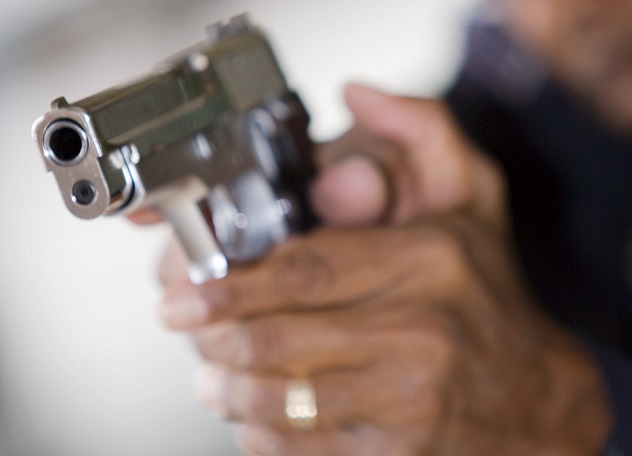 Music
Music  Music
Music  History
History 10 Less Than Jolly Events That Occurred on December 25
 Weird Stuff
Weird Stuff 10 Funny Ways That Researchers Overthink Christmas
 Politics
Politics 10 Political Scandals That Sent Crowds Into the Streets
 Weird Stuff
Weird Stuff Ten Bizarre Facts About The Doge Meme
 Our World
Our World 10 Ways Your Christmas Tree Is More Lit Than You Think
 Movies and TV
Movies and TV The 10 Coolest Stars to Set Sail on The Love Boat
 History
History 10 Things You Didn’t Know About the American National Anthem
 Technology
Technology Top 10 Everyday Tech Buzzwords That Hide a Darker Past
 Humans
Humans 10 Everyday Human Behaviors That Are Actually Survival Instincts
 Music
Music 10 Surprising Origin Stories of Your Favorite Holiday Songs
 History
History 10 Less Than Jolly Events That Occurred on December 25
 Weird Stuff
Weird Stuff 10 Funny Ways That Researchers Overthink Christmas
Who's Behind Listverse?

Jamie Frater
Head Editor
Jamie founded Listverse due to an insatiable desire to share fascinating, obscure, and bizarre facts. He has been a guest speaker on numerous national radio and television stations and is a five time published author.
More About Us Politics
Politics 10 Political Scandals That Sent Crowds Into the Streets
 Weird Stuff
Weird Stuff Ten Bizarre Facts About The Doge Meme
 Our World
Our World 10 Ways Your Christmas Tree Is More Lit Than You Think
 Movies and TV
Movies and TV The 10 Coolest Stars to Set Sail on The Love Boat
 History
History 10 Things You Didn’t Know About the American National Anthem
 Technology
Technology Top 10 Everyday Tech Buzzwords That Hide a Darker Past
 Humans
Humans 10 Everyday Human Behaviors That Are Actually Survival Instincts
10 Shocking Controversial Self-Defense Cases
Few recent events have led to more heated and divisive reactions than the fatal shooting of 17-year-old Trayvon Martin on February 26, 2012. Even though his shooter, George Zimmerman, was ultimately acquitted, it will forever be debated whether he was legitimately defending himself or committed cold-blooded murder. Homicides involving the alleged use of self-defense are often the subject of debate because it is difficult to definitively prove or disprove what really happened. In some cases, people have used a self-defense claim to successfully get away with murder. In others, a person has been unjustly prosecuted for simply defending their own life. Whatever the outcome, self-defense cases usually manage to generate controversy.
10 Odell Waller
1940

One of the most controversial executions in the history of the United States involved a 25-year-old African-American sharecropper named Odell Waller. In 1940, Waller and his wife lived in Gretna, Virginia and worked as sharecroppers for a white landlord named Oscar Davis. Davis allegedly fell behind in paying money which was owed to the Wallers and subsequently evicted the couple from his land when they refused to do any more work for him. The situation was worsened when Waller’s cousin helped Davis harvest some wheat and Davis refused to give the Wallers their fair share. On the morning of July 15, Waller went to the Davis farm to get the wheat from him. After a heated argument, Waller wound up shooting Davis with a .32 caliber pistol.
Davis would die from his wounds two days later, and after a massive manhunt, Waller was apprehended in Ohio. While Davis’s family and one of his farmhands claimed that Waller shot him without provocation, Waller claimed that he fired in self-defense after Davis reached into his own pocket for a gun. Nevertheless, the all-white jury found Waller guilty of premeditated murder and he was sentenced to death. However, Waller’s attorneys argued that he was not given a fair trial since the jury was comprised exclusively of citizens who could pay the poll tax. This meant that most African-Americans were not eligible for jury service and a national campaign was launched to commute Waller’s sentence. One of his biggest supporters was First Lady Eleanor Roosevelt, who attempted to convince her husband to stop the execution. Even though Waller did manage to win three stays of execution, his appeals were ultimately denied and he was put to death in the electric chair on July 2, 1942.
9 Larry Davis
1988

Under normal circumstances, a suspected murderer who shot and wounded six police officers would have the book thrown at him, but the case of Larry Davis is an unusual one. In 1986, Davis was a career criminal who was considered a suspect in the murders of four drug dealers. On the evening of November 19, over two dozen New York police officers prepared to raid a Bronx apartment building where Davis was hiding. Davis was inside his sister’s apartment when seven officers came bursting in. Who fired first is unclear, but Davis used a sawed-off shotgun and .45-caliber semi-automatic to wound six of the officers. Davis somehow managed to escape that night, but surrendered on December 5 after taking hostages at another building.
Davis was initially tried for the murders of the four drug dealers, but his attorneys put forth shocking allegations that he was the victim of an elaborate frame-up job. They claimed that Davis was part of a drug ring run by corrupt cops and that the murder charges had been fabricated so that police would have an excuse to kill him during a raid. The jury was convinced by this story and acquitted Davis. He was then given a separate trial for the shooting of the police officers and Davis’s attorneys once again argued that he fired at the cops in self-defense to save his own life. While the jury found Davis guilty of weapon possessions charges, they ultimately believed his self-defense story and acquitted him of attempted murder and aggravated assault. However, Davis’s string of good luck came to an end when he was found guilty of another murder in 1991. While serving his sentence at Shawangunk Correctional Facility, he was stabbed to death by an inmate in 2008.
8 Lena Baker
1944

Lena Baker was a poor African-American woman living in the town of Cuthbert, Georgia in the 1940s, who took whatever work she could find in order to support her three children. She was hired by a white grist mill owner named Ernest Knight, who needed someone to care for him while he recovered from a broken hip. Baker continued to work for Knight for the next two years and scandalous rumors began to spread that the two of them were involved in a sexual relationship. However, the relationship was an abusive one and Knight often held Baker against her will. On April 30, 1944, Knight locked Baker up inside the grist mill and demanded she have sex with him at gunpoint. After he tried to attack her with a metal pipe, Baker grabbed Knight’s pistol and shot him through the head before escaping. Even though Baker claimed the shooting was self-defense, she was charged with capital murder.
Her trial took place in August, where she was found guilty by an all-white, all-male jury and sentenced to death. On February 23, 1945, Lena Baker became the only woman in the history of Georgia to be executed when she was placed into the electric chair at Reidsville State Prison. She used her final words to maintain that she acted in self-defense. Baker’s case was forgotten about for several decades until her family went to the Georgia Board of Pardon and Paroles in an attempt to clear her name. In 2005, they determined that the execution was unjust and that, at the very maximum, Baker should have only received a 15-year sentence for voluntary manslaughter. In the end, Lena Baker was finally granted a posthumous pardon.
7 Joan Little
1974

Joan Little was a 20-year-old African-American woman who was frequently in trouble with the law. In 1974, she was charged with larceny and breaking and entering in her hometown of Washington, North Carolina. On June 4, Little was convicted of all charges and received a sentence of 7–10 years. She was held at the Beaufort County Jail as she appealed her conviction. Sometime during the evening of August 27, Little escaped from the facility and the body of 62-year-old jailer, Clarence Alligood, was found her in her cell. He had been stabbed several times with an ice pick and was naked from the waist down. One week later, Little decided to turn herself in to the authorities and was charged with first-degree murder.
Little claimed that she only killed Alligood in self-defense after he attempted to rape her. Her story was that Alligood had tried to solicit sex from her on three occasions that night and brought an ice pick into the cell to force her to perform oral sex on him. A semen stain on Alligood’s leg seemed to support her claims. Since Alligood was white and Little was facing the death penalty for his murder, her case garnered a lot of attention from civil rights activists, who helped raise money for her defense. Little’s attorneys were able to get her trial moved to Raleigh after convincing the judge that many of the residents of Beaufort County held prejudicial beliefs towards black women. While the prosecution attempted to claim that Little deliberately seduced and murdered Alligood in order to escape, the jury—consisting of six white and six black people—believed Little’s claims of self-defense and acquitted her.
6 Nancy Seaman
2004

In 2004, a 52-year-old Farmington Hills, Michigan teacher named Nancy Seaman was planning to divorce her husband Bob. The couple had been married for 31 years and had two sons together, but Nancy allegedly suffered through many incidents of spousal abuse. On the morning of May 10, an enraged Bob supposedly found out that Nancy was going to move out of the couple’s home and chased her into the garage with a kitchen knife. She responded by striking him 15 times with a hatchet before grabbing the knife and stabbing him 21 times. Remarkably, Nancy actually went in to work at school after killing her husband since she couldn’t find a substitute teacher. One week later, she would be charged with first-degree murder after police found Bob’s body wrapped in tarp in the back of her sport utility vehicle.
Nancy claimed that she only killed her abusive husband in self-defense, but the authorities were convinced it was premeditated murder, especially after surveillance footage surfaced of Nancy purchasing the hatchet from a Home Depot the day before Bob’s death. While the couple’s youngest son confirmed Nancy’s stories of abuse at the hands of Bob, their oldest son claimed to have never witnessed any abuse. Nancy maintained her claims of self-defense throughout her trial but was ultimately found guilty and given a life sentence. In 2010, Nancy successfully appealed to have her conviction overturned on the basis of ineffective legal counsel, as her attorney had failed to develop a strong case to prove she was a victim of “battered woman syndrome.” However, in November 2012, the federal appeals court overturned the decision to grant Nancy Seaman a retrial, so she remains in prison.
5 Danny Shay
1917

After a relatively unspectacular career in the majors, Danny Shay became a minor league baseball manager and was hired to manage the Milwaukee Brewers of the American Association in 1917. On May 3, the team had traveled to Indianapolis and was staying at the Hotel English. Shay went into the hotel’s cafe that night with a female companion named Gertrude Anderson and complained about the lack of sugar in the bowl on his table. When a black waiter named Clarence Euell came to deal with his complaint, the situation somehow escalated into an argument. Shay responded by pulling out a gun and shooting Euell in the abdomen. This led to a brief scuffle in which Euell wrestled Shay to the ground and stomped on his head. After the two men were separated, Euell was taken to a hospital. He died one hour later and Shay was charged with second-degree murder.
Shay always maintained that he shot Euell in self-defense after Euell attacked him and threatened to kill him. At the trial, Gertrude Anderson backed up his story, claiming that Euell had used abusive language and lunged at Shay before the shooting occurred. However, most of the other employees from the cafe denied that Euell made any attempt to attack Shay. In the end, the jury believed Shay’s story and acquitted him, a verdict which was met with much criticism from the media and the black community. In spite of his success at beating the murder charge, Shay would lose his managerial job with the Brewers and his own life came to an ill-fated end ten years later when he was found dead in a Kansas City hotel room of a self-inflicted gunshot wound.
4 Basil Parasiris
2007

Basil Parasiris was a 41-year-old businessman who lived with his wife and two children in the South Shore region of Montreal. In the early morning hours of March 2, 2007, the Parasiris family was awakened by a surprise visit from nine police officers from the suburb of Laval. The police suspected Parasiris of drug trafficking and had a warrant to search his home. In order to prevent Parasiris from being able to destroy potential evidence, this warrant allowed the cops to use “dynamic entry” and enter the home without knocking. They entered Parasiris’s bedroom with their guns drawn, but Parasiris grabbed his .357 Magnum and fired at them. Constable Daniel Tessier was shot twice and killed instantly while Parasiris’s wife and another officer were wounded in the ensuing gunfire. When Parasiris realized the intruders were police officers, he immediately dropped his weapon.
Parasiris was charged with first-degree murder, but maintained that he only acted in self-defense to protect his family. Since the police officers were in plainclothes and did not identify themselves, Parasiris assumed it was a robbery attempt. Even though Parasiris admitted to being involved with drug trafficking years beforehand and there was a small amount of cocaine found in his house, there was nowhere near enough evidence to justify the use of a “dynamic entry” search warrant. A judge determined that the warrant was illegal and would be inadmissible in court. In June 2008, Parasiris was put on trial and acquitted of the shooting of Constable Tessier. He did eventually receive a 20-month sentence for storing illegal firearms in his home, but was paroled after only serving five months.
3 Winnie Ruth Judd
1931

Winnie Ruth Judd was a 26-year-old medical secretary working in Phoenix, Arizona in 1931. Her husband had recently moved to Los Angeles to start a new practice, so Judd moved in with two female friends, Agnes Anne LeRoi and Hedvig Samuelson. On the evening of October 16, LeRoi and Samuelson were both shot to death with a .25 caliber handgun. Samuelson’s body was dismembered and both victims were stuffed into separate shipping trunks, which Judd took with her on a train trip to Los Angeles. The foul odor from the trunks eventually aroused the suspicion of a baggage agent who turned them over to the police. Judd was soon arrested and charged with the murders.
Rumors started that Judd killed LeRoi and Samuelson because all three women had a romantic interest in a married businessman named Jack Halloran. Judd had a gunshot wound on her left hand and claimed she killed her roommates in self-defense after they attacked her in a jealous rage, but the prosecution argued that the wound was self-inflicted. Judd was convicted of first-degree murder and sentenced to be hanged, but was later found to be mentally incompetent and sent to an insane asylum. However, things took a surprising turn once it was revealed that Judd and Jack Halloran were involved in an affair and that he may have been involved in the murders. Judd testified at a preliminary hearing against Halloran and claimed that he helped her dispose of the bodies, but the charges against Halloran were ultimately dismissed. Judd was officially paroled in 1971 and died in 1998 at the age of 93. To this day, some people speculate that Halloran may have been the actual murderer and that Judd simply helped him cover it up.
2 Rachel Wade
2009

Much of the controversy in the Zimmerman-Martin shooting stemmed from Florida’s “Stand Your Ground” law, which allows individuals to use deadly force in order to defend themselves. Three years before that case, “Stand Your Ground” was at the center of another controversial homicide involving two teenage girls from Pinellas Park. 19-year-old Rachel Wade and 18-year-old Sarah Ludemann had become involved in a love triangle with a young man named Josh Camancho. When Josh broke up with Rachel and hooked up with Sarah, the two girls began a heated rivalry, especially after Josh started seeing Rachel again. Rachel and Sarah frequently harassed and threatened each other and Rachel even left voicemails in which she vowed to murder Sarah.
On the evening of April 14, 2009, Josh was supposed to visit Rachel at her apartment, but decided to hang out with Sarah at his place instead. Rachel grabbed a steak knife and waited outside Josh’s house, where she threatened Sarah over the phone. Sarah soon followed Rachel to a friend’s house and nearly ran her down with her car. Once Sarah exited the vehicle, Rachel stabbed her to death through the heart and would be arrested and charged with second-degree murder.
Rachel claimed she had taken the steak knife for defensive purposes and only stabbed Sarah because she feared for her life. Since Sarah was much bigger than Rachel, her attorneys used the “Stand Your Ground” law to claim self-defense. However, witnesses for the prosecution claimed that Rachel immediately stabbed Sarah before she even climbed out of the car. When recordings of Rachel’s threatening voicemails were played for the jury, it was enough to convince them to find her guilty and she was sentenced to 27 years in prison.
1 Ossian Sweet
1925

In 1925, an African-American physician named Ossian Sweet purchased a home in an affluent white neighborhood in Detroit. On September 8, Ossian moved into his new house with his wife and infant daughter, but was unnerved by the crowds of angry-looking people who gathered around to watch him. Detroit already had several recorded incidents of black residents being driven from their homes after moving into all-white neighborhoods, so Ossian had police officers stationed around his house the following evening. He also invited his two brothers, Henry and Otis, and seven other acquaintances to his home to serve as extra protection. However, a large mob of nearly 1,000 people showed up and began making racist threats. Once the crowd started throwing rocks at the house and rushing towards it, shots were fired from the upstairs window. The bullets ended up killing a man named Leon Breiner and wounding another man in the leg.
Ossian Sweet, his wife, his two brothers, and their seven friends were all arrested and charged with murder. The case soon drew the attention of the NAACP and renowned attorney Clarence Darrow was brought in to join the defense team. The trial took place in front of an all-white jury, but Darrow argued that all of the defendants were in legitimate danger that night and that Ossian was simply exercising the right to defend his home. In the end, the jury deadlocked on every single one of the verdicts and a mistrial was declared. The prosecution then elected to try each of the defendants separately, but after their first trial against Henry Sweet ended in acquittal, they ultimately decided to drop all charges against Ossian Sweet and the remaining defendants.
Robin Warder is a budding Canadian screenwriter who has used his encyclopedic movie knowledge to publish numerous articles at Cracked.com. He is also the co-owner of a pop culture website called The Back Row and recently worked on a sci-fi short film called Jet Ranger of Another Tomorrow. Feel free to contact him here.








